NEC PA301w: The Baddest 30-inch Display Around
by Brian Klug on March 1, 2011 8:00 AM ESTViewing Angles
I almost don't need to say it, but the PA301w has superb viewing angles just as advertised. In both the horizontal and vertical directions, there's almost no distortion until viewed at the most extreme of angles. There's a bit more sensitivity in the vertical direction, but the difference is essentially insubstantial. Using the display in portrait is actually just an awesome testament to how good those viewing angles are - it's completely useable with no annoyances.
It's actually mind-blowing to use something this vertical to browse the net for even a few hours.
Color Quality
Next up are the ever-important color quality metrics. As usual, we report two main quality metrics: color accuracy (Delta-E) and color gamut. Color gamut refers to the range of colors the display is able to represent with respect to some color space. In this case, our reference is the AdobeRGB 1998 color space, which is larger than the sRGB color space. Our percentages are thus reported with respect to AdobeRGB 1998, and larger is generally better unless you're dealing with sRGB content and colorspace-unaware software.
Color accuracy (Delta E) refers to the display’s ability to display the correct color requested by the GPU and OS. The difference between the color represented by the display, and the color requested by the GPU is our Delta-E, and lower is better here. In practice, a Delta E under 1.0 is perfect - the chromatic sensitivity of the human eye is not great enough to distinguish a difference. Moving up, a Delta E of 2.0 or less is generally considered fit for use in a professional imaging environment - it isn’t perfect, but it’s hard to gauge the difference. Finally, Delta E of 4.0 and above is considered visible with the human eye. Of course, the big consideration here is frame of reference; unless you have another monitor or some print samples like a Gretag Macbeth color checker card to compare your display with, you might not notice.
As I mentioned in our earlier reviews, we’ve updated our display test bench. We’ve deprecated the Monaco Optix XR Pro colorimeter in favor of an Xrite i1D2 since there are no longer up-to-date drivers for modern platforms. We're trying to find an i1Pro to use as well.
For these tests, we calibrate the display and try to obtain the best Delta-E we can get at both 200 nits of brightness for normal use, and 100 nits for print brightness. We target D65 and a gamma of 2.2, but sometimes the best performance lies at native temperature and another gamma, so we try to find what absolute absolute best-case performance for each display. We also take an uncalibrated measurement to show performance out of the box using either the manufacturer supplied color profile, or a generic one with no LUT data. For all of these, dynamic contrast is disabled, and displays are left to settle for a half hour after making changes. The PA301w is CCFL-backlit, and I used a settle time of 30 minutes accordingly.
With the PA301w, I used the internal calibration routine to get me close, and then HCFR and the advanced OSD to get the color tristimulus primary values perfect. Then I calibrated with ColorEyes Display Pro.
First up is uncalibrated Delta-E performance. For this test, I took the monitor out of the box, connected it over DisplayPort, adjusted to 200 nits, and ran our usual GMB color checker test.
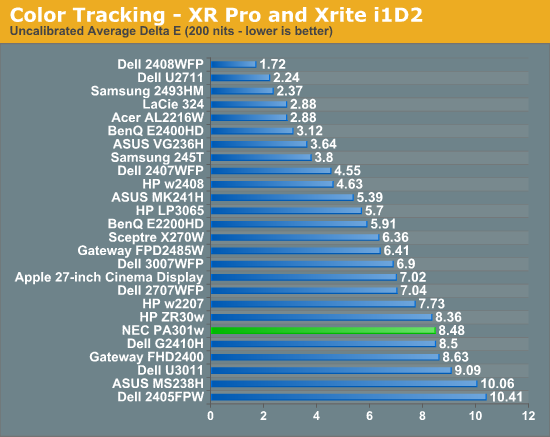
I took our uncalibrated test literally and ran this before using internal calibration either. Unsurprisingly, results aren't very good, and we see pretty middling performance out of the PA301w without any calibration. That said, if you're getting a professional monitor, you're hopefully going to calibrate it so you can actually enjoy what you're paying for. I didn't test, but running the in-monitor calibration alone has to help this out somewhat.
Moving on to the important 200 nit calibrated results, we can see the PA301w do very well, but still not displace the HP ZR30w result. I spent a lot of time trying to squeeze everything I could out of the PA301w and Delta E of 1.09 was as good as things would get. The result is still very good, I was just hoping to see something below 1.0 across the board like Jarred used to consistently. I'm beginning to suspect the i1D2 simply isn't as good of an instrument as the XR Pro, and what we're seeing is just instrumentational error creep in.
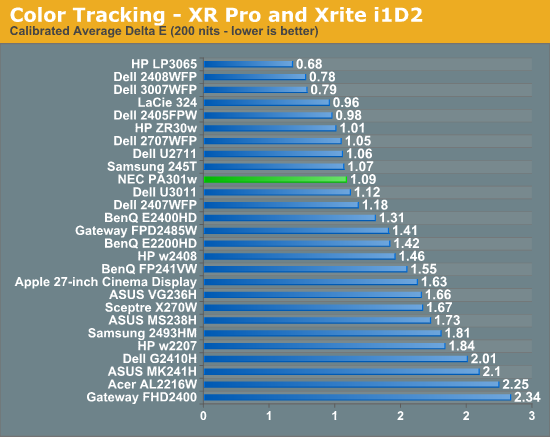
The PA301w doesn't have the typical spiky peaks that other displays which lack RGB controls show, which is great to see. You can see that the ZR30w still leads in some places, though the PA301w is clearly better in the greys.
At 100 nits, the PA301w pulls away and narrowly edges out the rest of the 30-inchers. Again, we still don't get a result that's under 1.0, but the numbers are obviously good enough for professional use.
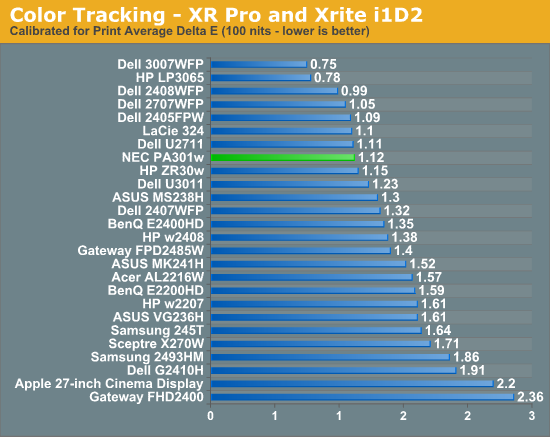
I'm impressed with color tracking on the PA301w and honestly think it can do better if we had an i1Pro spectroradiometer. I'm trying to get our hands on a good one, so we might just see it soon for these more serious display reviews.
Gamut percentage is important as well, and this is the only real place I think the U3011 has a distinct advantage. The PA301w has a "FULL" picture setting preset in the OSD which seems to change the red green and blue values to the edge of the display's supported gamut size. You can adjust further, however the labels turn pink which indicates that they're outside of the gamut. I went with full and took a reading, as expanding manually beyond didn't change the value any further. We can also see that the sRGB mode really clamps down on gamut percentage, and definitely works. There's also an AdobeRGB mode and a number of other common color spaces included. The PA301w uses an internal LUT to map color.
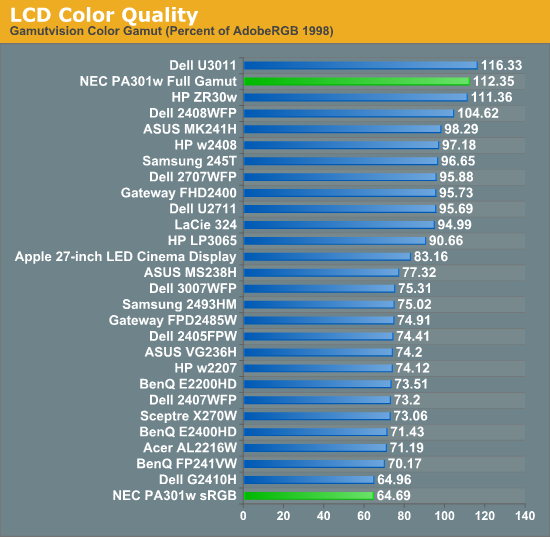









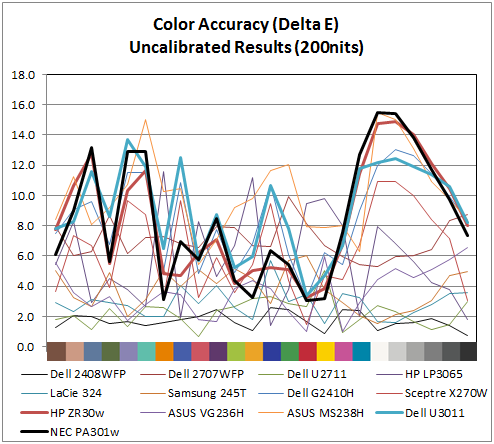
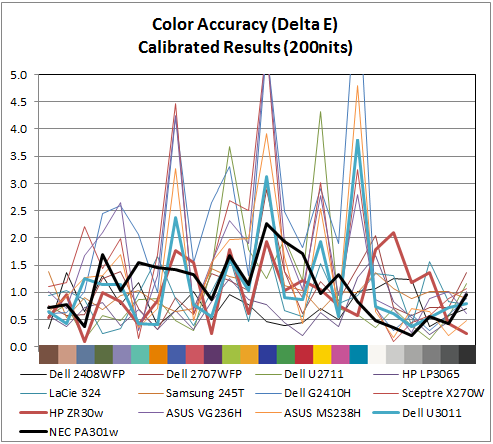









92 Comments
View All Comments
bossanova808 - Thursday, March 3, 2011 - link
Having tested this in practise, the 'working quite well' in practice means glitchy as anything. Half the tools don't work properly in terms of rendering around the cursor...if you more thoroughly browse Chris's comments on it in the PS forums, you'll see he acknowledges this.SanX - Tuesday, March 1, 2011 - link
Must be 4K for $2K.Only 100 DPI, or 184 implied DPI ? For $2K ? I see every pixel on it
Griswold - Wednesday, March 2, 2011 - link
Dont talk about things you dont understand, please.bossanova808 - Tuesday, March 1, 2011 - link
Hi FolksIf you're going to start commenting on colour accurate monitor like the NEC PA series or the Eizo CG series, you're going to need to seriously step up both your knowledge and methodology I'm afraid.
You should probably provide a caveat in this review, as the whole colour and uniformity section is pretty much flat out wrong.
For starters, your ED2 is simply not the right sensor to use with sort of monitor - designed quite some years ago now, it's simply incapable of reading the wider gamuts of modern displays accurately. Essentially any other sensor would do better - the Eye One Pro is the obvious choice for you guys I'd say, but really a Munki, Spyder3 or similar would be a better starting point. This has probably lead to the likely very erroneous reading of 5600K for the from factory whitepoint - almost all the PAs seem to come out of the factory bang on 6500K when properly tested. The ED2 is absolutely crap at measuring the primaries on monitors like these.
The NEC sensor has tweaked filters to cope with these monitors and does a much better job but you probably need a general purpose solution like the Eye One Pro.
Further, for calibration, this monitor is crying out to be used with SpectraView2 which is NEC's direct hardware calibration software that can directly manipulate the 14 bit monitor LUTs. Basically, not using this software is kind of defeating the point of using a display like this.
You might want to contact Will Hollingsworth at NEC Colour Critical Displays to have a chat and see if you can't re-visit some of this testing with better methodology & equipment.
eaw999 - Wednesday, March 2, 2011 - link
agreed 100%.bossanova808 - Wednesday, March 2, 2011 - link
...basically, the Mac can't do 10 bit right now (confirmed by both Apple and Adobe), and while the PC has 10 bit support int he OS and it generally works, there are some big issues - Aero effects gets turned off, and apps that sort of support 10 bit like Photoshop have some big glitches still (you can see PS render an 8 bit working square around the cursor with some of the tools that aren't 10 it ready!) - most likely Win8 and Photoshop CS6 will be where 10 bit really comes in to play.softdrinkviking - Wednesday, March 2, 2011 - link
and when 10 bit color finally "comes into play," is it really going to make much of a difference?or should i say, will most people even be able to tell the difference?
DanNeely - Wednesday, March 2, 2011 - link
Probably nto much. The main benefit will likely be being able to render images marked as sRGB on an extended gamut display without banding or over saturation problems.bossanova808 - Thursday, March 3, 2011 - link
Err, dan that isn't right. sRGB rendering on the PA series is already remakrably good and there's no banding issues. The over saturation issues come mainly from non CM stuff, particularly OS elements and the like, that are sent as raw RGB numbers and thus appear quite oversaturated. I think you'll see UI designers tone down the colour going forward...The main benefit will most likely be considerably better control of colour in deep shadows.
softdrinkviking - Wednesday, March 2, 2011 - link
Thanks for the response...This is what I could dig up for the community, or any curious bystanders...
First of all, NEC just redid their whole website like yesterday! so I can't find exactly the same info I was referring to.
But... here is an excerpt from the FAQ for the Spectraview2 software...
" Which is better: a colorimeter or spectrophotometer such as the X-Rite iOne Pro?
In general a spectrophotometer provides more accurate color measurements than a "generic" colorimeter does when measuring most displays. However a colorimeter can be specifically calibrated against a lab grade instrument to match a particular type of display, and thus provide extremely accurate color measurements. This approach was taken with the new custom-calibrated X-Rite iOne Display V2 included in the Display Calibration Bundle.
A spectrophotometer can suffer from drift and low luminance noise issues that can cause problems—specifically when measuring and calibrating near black. In general colorimeters provide superior low luminance measurements than spectrophotometer."
So a couple of interesting things are said here. 1. Colorimeters can be better than uber-expensive spectrophotometers in certain metrics and 2. That NEC specifically calibrates their version of the x-rite meter to compensate for the shortcomings of the colorimeter process.
So, if NEC is to be believed, you need an NEC branded meter to achieve better than so-so results from a generic colorimeter.
here's the link to that, split-up, if you wanna see for yourself...
http:// necdisplay. com /support-and-services/spectra-view-II/FAQ